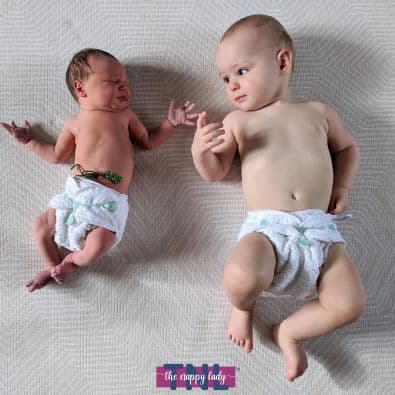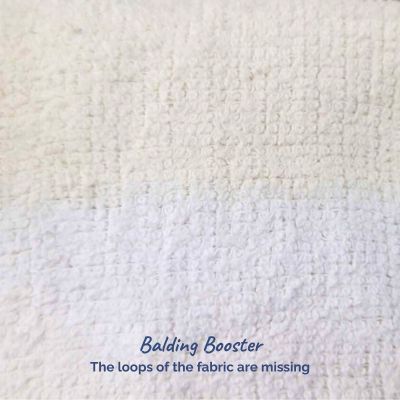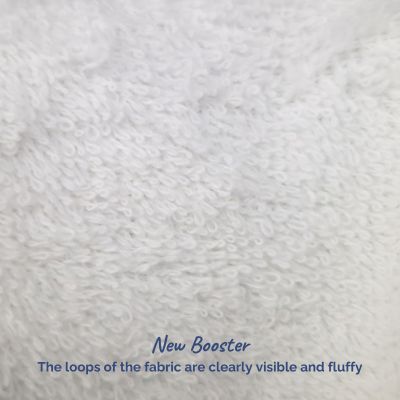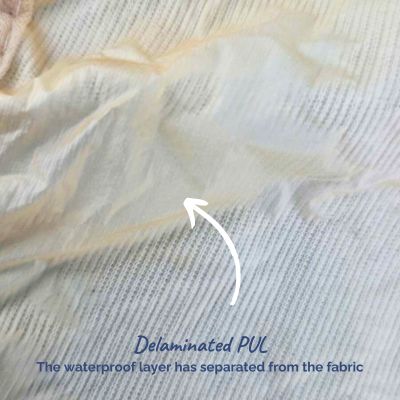Maximising Lifespan: How Long Do Reusable Nappies Last?

If you’re considering the switch to reusable nappies or already using them, a practical question on your mind is likely ‘how long do reusable nappies last?’ On average, expect a set of good quality reusable nappies to serve you well for up to four years with proper care. This article delves into what factors contribute to their longevity, from fabric quality to care routines, and provides insights into maximising the lifespan of your investment.
Key Takeaways
-
The lifespan of well-cared-for reusable nappies is around four years, with factors such as usage frequency, material quality, and care influencing their durability.
-
Appropriate care, including proper washing at advised temperatures, avoiding fabric softeners and bleach, rotation of nappies, and air drying, can considerably extend the life of reusable nappies.
-
Signs of wear and tear such as threadbare areas, PUL damage, or persistent odours after washing indicate that reusable nappies may need to be retired and replaced.
Understanding the Lifespan of Reusable Nappies
Ever wondered how long do reusable nappies last? Generally, a set of well-cared-for reusable nappies can last about four years, potentially accommodating two children, with only occasional replacements needed. However, the lifespan of cloth nappies can vary considerably based on the quality of materials, manufacturing practices, and individual usage. This means that your nappy stash can last for a few years, making it a financially sound and environmentally-friendly choice over disposables.
Next, we will explore several factors that impact the durability of your reusable nappies, such as the frequency of use, material quality, and indications of wear and tear. We will also provide advice on caring for your nappies to prolong their usefulness.
The Impact of Usage Frequency
One of the significant determinants of the lifespan of your reusable nappies is how frequently they are used and washed. When considering how many nappies you’ll need, keep in mind that according Little Lamb and Bambino Mio reusable nappies typically last for around 400 washes before significant degradation occurs. This means, if you wash each nappy 2-3 times a week, it should last for about four years.
However, washing them more frequently can reduce their reliability. Thus, maintaining a sufficient rotation of nappies can help avoid excessive washing of a specific set and prolong their lifespan. A full time set of 20 nappies will last longer than a set of 10 nappies which are washed daily.
Quality Matters: Material and Construction
The durability of your reusable nappies is significantly influenced by their material and construction. Not all nappies are created equally!
Some factors to consider for durable reusable nappies are:
-
High-quality materials used greatly enhance their longevity. I have seen Mother-ease Sandys that have been used for over 10 years and they still look in fabulous condition.
-
Durable fabrics like hemp and cotton are ideal for reusable nappies.
-
Bamboo is a more delicate fibre and wears quicker than cotton no matter how carefully you care for it. Bamboo is sometimes mixed with other materials such as cotton to ensure longevity.
-
Organic cotton can have a tendency to wear quicker than regular cotton.
-
The quality of construction, including the elastic and PUL, impacts the nappy’s lifespan, with better-quality elements enhancing durability. Mother-ease are famous for their long lasting exceptionally high quality elastics whereas other brands we see elastics relaxing within a year.
So, before investing in reusable nappies, ensure you’re going for most brands that use durable and high-quality materials.
When Nappies Retire: Signs of Wear and Tear
Like all other products, reusable nappies will eventually exhibit wear and tear, indicating that their lifespan is nearing its end.
Visible cues such as balding in places, a threadbare appearance, the development of rips, or PUL damage indicate that it’s time to retire the nappy. As fabric wears away on a nappy, the absorbency also decreases.
A reusable nappy may need replacement if it shows reduced absorbency or has lingering odours after being washed.
Two-piece reusable nappy systems do not always have their nappy and waterproof parts replaced at the same rate. This is the wonderful thing about two part nappy systems if one part wears out it can be replaced on it's own whereas all in one nappy systems the entire nappy need replacing.
Care and Maintenance Strategies
Proper care and maintenance can significantly extend the lifespan of your reusable nappies. This includes following the manufacturer’s care instructions, washing at appropriate temperatures, and air drying.
Using recommended nappy cleanser, laundry bags, a nappy bucket, and nappy liners all aid in proper nappy care.
Ensure you wash your soiled nappies every 2 to 3 days maximum. The longer soiled nappies are left the greater the risk of long term damage to the fabric. Some people recommend running a daily rinse cycle on used nappies awaiting washing but this increases the amount of mechanical wear and tear a nappy receives and is not a recommended method by any of the large reusable nappy manufacturers.
For effective washing, reusable nappies should be laundered no higher than 60C with adequate detergent dosage personalised for machine size and water hardness. Additionally, a proper washing machine load is crucial for the main wash cycle to ensure adequate agitation and prevent excessive suds.
Washing in high temperatures frequently can reduce the lifespan of elastic in nappies, and the recommended drying techniques include line drying on a breezy day, an indoor drying rack, or using a cool tumble dryer.
Rotating reusable nappies within your collection can prevent premature wear by ensuring each nappy is used proportionately, and routine care should be followed even with rigorous use.
Washing Wisdom: Preserving Fabric Integrity
The way you wash your reusable nappies can significantly impact their fabric integrity. To protect the fabric, avoid the use of chlorine-based bleaches and fabric conditioners.
A two-step wash routine for reusable nappies is recommended, starting with a preliminary wash to remove excess waste, followed by a longer main wash with an adequate amount of detergent designated for heavily soiled items. This helps mitigate detergent build-up and ensures your nappies are thoroughly cleaned.
Drying Do's and Don'ts
While drying may seem like a straightforward task, it’s important to follow the correct procedures to prevent fabric degradation. Air drying nappies can prevent fabric degradation caused by heat from tumble dryers, which is crucial for maximizing their lifespan.
The lint in the tumble dryer fluff filter is fibres coming off your nappies. The fluff represents tiny amounts of lost absorbency which overtime will build up to wear and tear you can see with the naked eye.
High heat machine drying can also damage components like elastic. It is recommended that any waterproof parts are always air dried and minimal dryer use for nappies if possible.
When using a heated airer, it is essential to:
-
Place a towel to prevent direct contact of the heat with bamboo fibres and PUL layers to avoid damage.
-
Ensure proper indoor drying involves ventilation to manage moisture effectively.
-
Make use of sunlight warmth when available.
Storing Solutions Between Babies
How you store your nappies between uses and between babies can also affect their lifespan.
Nappies should be stored in an airy basket without a lid, on a shelf or in a drawer to prevent bacterial growth and ensure they remain dry between uses.
If you plan to store your nappies for a long time, for instance, between babies do not store your nappies in a loft or garage where temperature extremes can occur. The recommended storage location for cloth nappies is a cool, dry area away from direct sunlight to prevent damage to the fabric and components.
Tackling Common Cloth Nappy Challenges
Despite their advantages, reusable nappies come with their own set of challenges. These include worn-out elastic, PUL degradation, and velcro damage. However, much of these can be mitigated through appropriate care and maintenance. Regular inspection of the nappies can help in identifying early signs of wear such as PUL degradation.
When wear and tear such as damaged velcro or severely worn-out elastic is observed, considering repair options or replacing the nappy might be necessary. Next, we will address some common issues associated with hard water and acidic urine, both of which can notably impact the lifespan of your reusable nappies.
Overcoming Hard Water Hurdles
Hard water can lead to the degradation of fabric fibres, causing cloth nappies to feel rough or stiff.
To counteract the effects of hard water on cloth nappies, use a cloth nappy-friendly water softener, warm water for enhanced detergent dissolving, and powdered detergents which often include water softeners.
Dealing with Acidic Wee
Acidic urine can cause significant damage to cloth nappies, such as brownish discoloration, brittle fabric and elastic, and the production of holes within 12 months. Rinse out urine especially on overnight nappies or during teething before placing nappies in the dry pail helps prevent the acid in the urine from deteriorating the nappy fabric.
Storing soiled nappies in a cool, well-ventilated space helps prevent damage while the nappies await washing. Most families keep their nappy bucket in the family bathroom.
Rotation and Replacement Rhythms
Rotating your nappy use ensures that wear is distributed evenly across the collection, extending the overall lifespan of the nappies. Considering a baby goes through over 1800 nappy changes in a year, rotation is crucial for managing the high volume of use and determining when to replace old nappies.
Next, we will explore the advantages of owning a wide selection of reusable nappies, as well as the occasional use of disposable nappies, and give advice on recognizing when it might be time to purchase new ones.
The Benefits of a Broad Collection
Having a larger collection of reusable nappies can decrease the wear on individual nappies, consequently extending their lifespan. With a collection of 20 nappies, each nappy is washed less frequently, such as every two days during the newborn phase, reducing strain from constant washing. Having an assortment of cloth nappy types allows for a diverse rotation that can adapt to different situations, lessening the wear on any particular nappy style.
Using size nappies also helps spread the wear considerably. If you used Tots Bots Bamboozle nappies size 1 would be used for approximately 6-9 months and then size 2 for the rest of time baby is in nappies. This spreads the wear significantly more than if the child had been in a onesize since birth.
Plus, a diverse collection of reusable nappies, washable nappies, cloth diapers, and reusable liner options enables a more appealing usage experience with various designs, colours, and fabric options.
Identifying When to Invest in New Nappies
Observing the condition of different cloth nappy types in rotation can help identify when certain nappies are at the end of their lifespan and need to be replaced. Regular check-ups can help you assess the condition of your nappies and make informed decisions about when to invest in new ones.
-
To check the condition of your elastics. Pull the elastics to stretch your nappy to full length. The elastics should feel springy, stretch and increase the length of the nappy and then retract back.
-
Look for thinning or balding patches. Areas that are thinning will be less absorbent.
-
Velcro. The teeth should be free from lint, lint can be removed with a nit comb. Check the tabs are stick and are staying closed.
-
PUL - Gentle stretch the PUL to see if any cracks are appearing. Look for delamination which will show as a separating layer inside the nappy. Try the tea towel test if you regularly get leaks.



Summary
In conclusion, the lifespan of reusable nappies largely depends on how they are used, cared for, and maintained. From understanding their lifespan to tackling common challenges, maintaining appropriate rotation and replacement rhythms, selecting the right materials for night time use and heavy wetters, to adjusting the fit as your baby grows - every aspect plays a crucial role in maximizing the benefits of reusable nappies. With proper care, your reusable nappies can serve you and your baby well for years, proving to be a cost-efficient and sustainable choice over disposables.
Frequently Asked Questions |
|---|
Is it cheaper to use reusable nappies?Yes, using reusable nappies is cheaper than using disposable nappies, making them a cost-effective and eco-friendly option. |
How many reusable nappies do I need full time?You will need around 15-20 cloth nappies for daytime and 3-5 for night-time use, or a minimum of 12 if you prefer to wash less often. |
How long should I expect my cloth nappies to last?The lifespan of cloth nappies can vary, but a set of well-cared-for reusable nappies can generally last about four years. |
What are some factors that impact the longevity of a cloth nappy?The lifespan of a cloth nappy is impacted by factors such as the size of the nappy stash, soaking practices, washing methods, drying techniques, and the type of fabric used. These factors need to be carefully considered to ensure the longevity of the cloth nappies. |
How often should reusable nappies be washed?Reusable nappies should be washed around 2 or 3 times a week. This frequent washing helps maintain hygiene and durability. |
